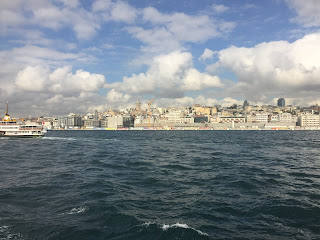The taxi
ride into town from Attaturk Airport is only about 12 miles but the ride took
over an hour. Our introduction to the horrendous traffic of Istanbul. We stayed
in the new district at the Pera Palace Hotel. Most of the tourist areas are in
the old town on the south side of the Golden Horn. In the late 19th
century, Greeks, Jews, and others settled to the north in an area called Pera,
‘the other side.’ The Pera Palas was built in 1892 to serve the westerner’s
coming to the exotic east via the Orient Express. Agatha Christie wrote her
famous novel, Murder on the Orient
Express, there.
The train landed in the old town at the still operative
Sirkeci Station, but the trip to the Pera Palas used the many boats to cross
the Golden Horn, maybe a ride then in the Tunnel to the top of the hill---the
third oldest subway in the world (after London and New York). We used it and
the Metro and the trams to get all about in the city.
Night one
after the long trip found us in the Orient Bar of the Pera Palace to have a
great martini. We then had mezzes at the bar for our dinner. They were the best
part of every meal.
Our second
night we had dinner at Istanbul 1924, formerly Rejans. After the Russian
revolution, many Russians settled in Istanbul and this Russian restaurant was
begun then. It is in the new town and a short walk from our hotel but we liked
to have never found it. It is located up a flight of stairs off a small alley,
off a short street, off the main drag, Istiklal Cadesssi. One small sign next to
the door.
We were not
disappointed. With period music playing we had cocktails and decided on the
tasting menu: Russian styled mezze, beef Stroganoff, and the dessert! It was
styled as Chocolate Faberge, a chocolate egg filled with a chocolate sponge and
raspberry ice cream and topped off at the table with the waiter pouring hot
vanilla custard melting the egg! It was truly an over the top dessert!
We ate most
all our meals in the New District and were able to walk to all. Views are
important in Istanbul and we had drinks and a meal at a bar overlooking the Bosphorus
as the sun set and the lights come on.
One
restaurant we liked enough to go twice was across the street from the hotel. It
was called The Lemon Tree but their specialty was mezze. One could pick from a
counter the number of cold mezzes and also order hot mezze. This is where I had
my first Shephard’s Salad and fell in love with it and ordered it at every meal
afterward. The recipe is so simple and is given below. You should add this to
you salad recipes.
Another was
a café that celebrated the food of Anatolia, the eastern part of Turkey. We had
noticed it on several occasions and on our last night we gave it a try. Our
mezze consisted of Cretan style mashed cheese with Zahter, basically a cheese
mashed with thyme and rolled in sesame oil and seeds, fava bean hummus, falafel
with yogurt and garlic sauce: so you can see some good stuff!
A real treat
was a cruise for 6 hours on the Bosphorus. The cruise lasted two hours going
almost to the Black Sea and two hours for lunch and two hours back to Istanbul.
A wonderful, beautiful sunny day and a lovely lunch by the water of fish just
caught and grilled (bonita) Shepherd’s Salad, and fried mussels in a yogurt
sauce, a local specialty, for an
appetizer.
One meal we
had in the Grand Bazaar began in a carpet shop and the usual chatter about
where are you from? Etc. Turns out the owner knew a physician that we knew in
Wilmington, NC. The carpet dealer had spent 2 weeks in the physician’s home. He
then stopped the carpet sale and invited us next door to lunch as his guest. We
had donner kababs (like gyros), my favorite Shepherd Salad, and we had Ayran
for a refreshing drink—yogurt with water and a little salt. A favorite
everywhere in Istanbul. A small world as we discussed all the people we both
knew. He’ll be back in the states this winter. Maybe we will see him.
The trip was
fantastic and if any of you care to venture abroad this is a terrific, easy,
and dare I say safe, destination!
Shepherd’s
Salad
Serves 2-4
Can use any
amount of ingredients and that is the beauty of this salad. Good ripe tomatoes
would be best.
Chop two
cucumbers in small bites. Chop three tomatoes into small bites. Can peel and
seed if you wish. Add a small pepper (hot or not) and cut into small rings. Add
a handful of parsley chopped. Pour some oil, vinegar, and lemon juice over the
salad (The waiters in Istanbul would come to the table with 3 cruets: oil,
lemon juice, and vinegar). Toss and grind some salt over all. You can add some feta
cheese over the salad if you wish. This is your salad and it is so good and
simple.

















































